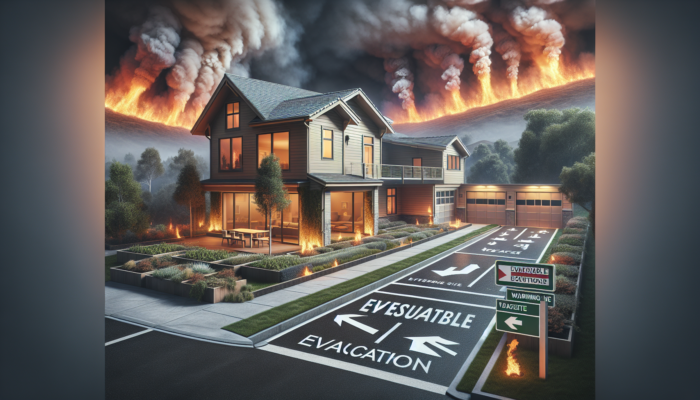Create Your Wildfire Evacuation Plan: Ensure Safety Through Preparedness and Awareness
With the escalating frequency of wildfires, it has become imperative to establish a detailed wildfire evacuation plan. Such a plan is vital not only for safeguarding your health but also for ensuring that you are adequately prepared to react effectively in emergency situations. By comprehensively understanding the range of threats presented by wildfires and formulating a robust evacuation strategy, you can significantly improve your chances of managing these perilous scenarios. This comprehensive guide is designed to equip you with essential knowledge and actionable steps, empowering you to deal with wildfire emergencies confidently and clearly.
Evaluating Wildfire Threats: Gain Insight into Your Community's Fire Vulnerability

To kickstart your wildfire preparedness efforts, it is essential to perform a thorough assessment of the wildfire risk present in your vicinity. Certain areas are inherently more vulnerable to wildfires due to climatic conditions, vegetation types, and proximity to natural reserves. To effectively plan, utilize local fire risk maps and resources provided by fire departments or environmental agencies. By identifying vulnerabilities related to your property—such as nearby vegetation types, unique terrain features, and historical fire incident records—you can significantly bolster your readiness against potential wildfire threats.
Preparedness levels vary significantly among communities, making it crucial to understand your local environment and how quickly a fire could spread. For instance, regions abundant in brush or trees face a higher risk compared to those with open spaces. Moreover, becoming acquainted with prevailing wind patterns is essential for anticipating an impending wildfire's behavior. Local fire departments often conduct detailed assessments that provide valuable insights, further strengthening your preparation and readiness.
Formulating a Reliable Evacuation Strategy: Essential Steps for Safe Departure
Developing a well-structured evacuation strategy is paramount during any wildfire emergency. Begin by identifying clear, accessible evacuation routes, taking into account possible road closures due to fire activity or emergency services. It is beneficial to outline at least two distinct routes to guarantee a swift exit, even if one route becomes obstructed or impassable. This proactive approach can make a critical difference when time is of the essence, ensuring you can evacuate efficiently.
Involve all household members in the planning process and stress the importance of adhering to the plan during emergencies. Regularly practice your evacuation route, especially for young children and elderly family members who may need additional support. Designate a safe meeting point outside the danger zone, ensuring everyone is aware of where to regroup if separated during the evacuation. This preparation instills a sense of security among family members, knowing they have a structured plan to follow.
Lastly, keep your evacuation strategy current. Changes in family dynamics, the addition of new pets, or the emergence of new hazards in your area may require adjustments to your evacuation strategy. Regularly reviewing and practicing your plan will build confidence within your family, equipping them to act promptly should the need for evacuation arise.
Building a Comprehensive Emergency Kit: Must-Have Supplies for Quick Exits
An emergency kit is an indispensable part of your wildfire evacuation plan. This kit should include all essential supplies to support you and your family for at least 72 hours away from home. Start with basic necessities such as water, non-perishable food items, and a first-aid kit. Additionally, consider packing personal hygiene products, flashlights, extra batteries, and any essential medications that family members may require to ensure their well-being.
Consider the specific needs of your household: if you have infants, be sure to include baby formula and diapers. Furthermore, pack vital documents like identification, insurance papers, and medical records, ideally stored in a waterproof container for protection. It is also wise to have a spare set of clothing and sturdy shoes for each family member, ensuring their comfort throughout the evacuation process.
Finally, don’t overlook comfort items such as blankets and toys for children, as these can provide emotional support during stressful situations. Regularly check and refresh your emergency kit to guarantee that all items are in good condition, not expired, and ready for immediate use when needed.
Strengthening Your Home's Resilience Against Wildfires: Protect Your Property

Preparing your home to withstand potential wildfire threats not only enhances your safety but also increases the likelihood that your property will endure a fire incident. Implementing protective measures can substantially minimize damage and facilitate a more efficient evacuation process, allowing you to focus on your family’s well-being during emergencies.
Securing Your Property: Effective Techniques to Fortify Your Home Against Wildfires
Strengthening your home against wildfires involves a series of proactive measures. Start by creating a defensible space around your property by clearing away dead vegetation, trimming overhanging trees, and ensuring a safe distance between your home and any combustible materials. The recommended defensible space typically extends at least 30 feet from your residence, but in high-risk zones, you may need to increase this distance further for optimal safety.
Consider utilizing fire-resistant materials for your roofing and siding. Options such as metal roofing, stucco, or brick exteriors can greatly enhance your home’s resistance to flames. Additionally, installing dual-pane windows can provide extra protection against heat and embers. Consistent maintenance is also key; ensure that gutters and roofs are regularly cleaned to prevent the accumulation of debris that could ignite during a fire.
Finally, ensure that your property allows adequate access for emergency responders. Wide driveways and clear pathways facilitate quicker responses from firefighting teams if they need to defend your home against encroaching flames, thereby increasing your chances of protection during a wildfire.
Managing Utilities Safely During Wildfire Evacuations: Shutting Off Gas and Electricity
Effectively managing utilities during a wildfire evacuation is crucial to minimize additional hazards. Before evacuating, familiarize yourself with the steps to safely shut off your gas, electricity, and water supplies. These actions can significantly reduce the risk of fires igniting on your property after you leave due to utility issues.
Start with the gas lines; locate your gas meter and learn how to turn it off. If you are unsure, contact your utility provider for guidance on executing this task safely. For electricity, switch off breakers to prevent power surges that could occur when the system is reactivated. This step is particularly critical if you live in an area where electrical lines are at risk of falling during a wildfire.
Finally, shutting off your water supply can help prevent flooding if pipes burst while you are away. Ensure you know where the appropriate shut-off valves are located, and train all family members to perform these essential tasks efficiently to avoid chaos during emergencies.
Creating a Comprehensive Inventory of Your Possessions: Documenting for Safety and Recovery

Maintaining a detailed inventory of your possessions can prove invaluable in the event of a wildfire. Documenting your belongings not only assists in insurance claims but also streamlines recovery efforts post-evacuation. Begin by taking photographs or videos of each room in your home, ensuring that you capture valuable items and their conditions in detail for future reference.
Store this documentation securely in an easily accessible location, such as cloud storage or a fireproof safe. Be sure to include receipts or appraisals for high-value items, as these documents can substantiate your claims during the recovery process and assist you in regaining what you have lost.
Regularly update your inventory to reflect new purchases or changes in your household. This practice not only aids in recovery after a disaster but also encourages periodic assessments of your possessions' value, which can be beneficial for insurance purposes and future planning.
Understanding Wildfire Evacuation Procedures: Essential Steps During an Evacuation Alert
When an evacuation alert is issued, taking swift and decisive action becomes essential to ensure your safety. Understanding how to respond and maintaining clear communication can greatly enhance safety during these critical moments, ensuring you and your loved ones remain secure.
Stay Informed: Utilize Alerts and Track Fire Progress Effectively
Remaining informed is paramount for your safety and preparedness during crises. Leverage local news outlets, social media platforms, and official government websites to monitor fire progression and evacuation orders. Many regions have established dedicated alert systems that send notifications via text or email, ensuring you receive timely updates regarding your situation and essential safety precautions.
Additionally, applications designed for emergency management can provide real-time information about wildfires, including maps that indicate current fire locations, ongoing containment efforts, and recommended evacuation routes. Prioritize downloading relevant applications and registering for alerts when you recognize the potential for wildfire threats in your area, as this will keep you informed and prepared.
Furthermore, a battery-operated radio can serve as a reliable backup for receiving information if power outages occur. Always plan to maintain communication with family members, ensuring that everyone understands how to stay updated during a crisis, thus enhancing your collective safety.
Establishing Effective Communication Plans: Stay Connected with Family and Neighbors
Creating a robust communication plan is crucial during an evacuation scenario. Designate a primary contact for family members who may become separated during a crisis, ensuring that everyone has access to each other’s phone numbers and understands how to reach you in an emergency.
Group messaging applications can facilitate communication among family and friends, allowing for quick updates regarding your safety and whereabouts. Moreover, establishing a predetermined meeting place outside the danger zone can be beneficial, providing a safe location to regroup if cellular service is disrupted during the evacuation.
Engaging with your neighbors can foster a sense of community and support during emergencies. Share your plans with them, and consider forming a neighborhood group to keep each other informed and assist one another during an evacuation, creating a stronger network of support.
Identifying the Safest Evacuation Routes: Selecting the Optimal Path Away from Danger
Knowing the safest routes is paramount when faced with an evacuation. Prior to any emergency, research and identify multiple evacuation routes from your home to ensure you have alternatives. This planning is critical, as wildfires can spread rapidly, and main roads may become congested or blocked due to fleeing residents or fire activity.
Consult local maps and engage with community resources to understand the most effective routes during a wildfire. Pay attention to any designated emergency routes recommended by local authorities, as these routes are often designed for swift and safe evacuations. Familiarizing yourself with these paths and occasionally driving them will ensure you can navigate them quickly when under stress.
During an evacuation, avoid driving through smoke or flames. Stay calm, heed local authorities' instructions, and follow their guidance regarding the safest routes to take. Prepare for potential traffic congestion and allow ample time to reach safety, as this foresight can reduce panic and enhance your overall safety during the evacuation.
Evacuating with Pets and Livestock: Prioritizing Animal Safety During Wildfires
Evacuating with pets and livestock requires meticulous planning and preparation to ensure their safety and welfare during a wildfire. Integrating all animals into your evacuation strategy is essential to protect their well-being and minimize stress during emergencies.
Creating Pet Evacuation Kits: Essential Supplies for Your Furry Companions
Assembling a pet evacuation kit is vital for ensuring your animals are safeguarded during an emergency. Start with basic supplies: food, water, and bowls, along with any medications your pets may require. Include essential documents such as vaccination records and identification tags, and consider having a recent photograph of your pets to assist in locating them if they become lost during the chaos of an evacuation.
In addition to supplies, ensure you have appropriate carriers or leashes for transport. Loading your pets into carriers beforehand will streamline the evacuation process and reduce the stress of a sudden departure. If possible, include comforting items such as blankets or toys, which can help alleviate stress for your animals in chaotic situations and provide a sense of familiarity.
Lastly, identify pet-friendly evacuation shelters in your area ahead of time. Knowing where to take your pets will alleviate worries and make the evacuation process more efficient, ensuring that both you and your animals have safe havens to turn to during emergencies.
Planning for Livestock Evacuation: Safely Transporting Your Larger Animals
Due to their size and specific needs, evacuating livestock requires careful planning and preparation. Start by evaluating your transport options, ensuring you have a reliable trailer or vehicle capable of safely accommodating your animals. This preparation is essential to avoid delays during emergencies when time is of the essence.
Establish a comprehensive plan for transporting your livestock before an emergency arises, including designated routes and destination points. It's crucial to have a safe and secure location where your animals can be housed during the evacuation. Collaborate with local farmers or agricultural organizations to identify potential shelters or boarding facilities that can accommodate your livestock, ensuring their care and safety.
In addition to transport logistics, prepare a livestock emergency kit that includes feed, water, and necessary veterinary supplies. Familiarize your animals with the trailer or transport vehicle in advance to minimize stress during the evacuation process, making the transition smoother for both you and your livestock.
Finding Reliable Sheltering Options: Safe Havens for Pets and Livestock
Identifying suitable shelter for pets and livestock is crucial during a wildfire evacuation. Numerous resources, including local animal control agencies, shelters, and community groups, can assist in locating safe havens for your animals during emergencies.
Before an emergency arises, research local animal shelters that accommodate pets during evacuations. Many communities have established partnerships with shelters to ensure animals receive care during times of crisis. Additionally, consult local veterinary clinics, which may offer boarding services during emergencies, providing another avenue for ensuring your pets are cared for.
For livestock, reach out to local agricultural organizations or extension services. They can provide guidance on available facilities and resources specifically designed for housing larger animals during evacuations. Being proactive in these efforts can lessen the stress of evacuation and ensure your animals are safe.
Understanding Wildfire Evacuation Protocols: Important Steps for Post-Evacuation Procedures
Once the immediate threat has passed, it is essential to approach the post-evacuation period with caution and mindfulness. Understanding the proper actions to take upon returning home can help ensure your safety and facilitate recovery efforts, making the transition back to normalcy smoother.
Returning Home Safely: Guidelines for Re-Entering Your Property
Re-entering your home after an evacuation requires vigilance and caution. Always wait for official notifications confirming it is safe to return to your property. Authorities will conduct assessments to determine when conditions are suitable for re-entry, and it’s crucial to heed their guidance for your safety.
Once you receive clearance, approach your home with care. Be alert to potential hazards such as downed power lines, unstable structures, or smoldering debris that could pose risks. If you encounter any active flames or smoke, evacuate immediately and notify local authorities to prevent further danger.
When re-entering your home, wear protective clothing, including sturdy shoes and a mask, to shield yourself from dust and debris that may have accumulated. Before unpacking or resuming normal activities, conduct a thorough inspection of your property for any damage or hazards that may have occurred during your absence, ensuring a safe environment for you and your family.
Assessing Damage: Key Steps for Evaluating Property Conditions
After returning home, evaluating damage is crucial for recovery efforts. Begin by documenting all visible damage and taking photographs or videos of affected areas. This documentation will be essential for insurance claims and recovery processes, serving as a record of what has been lost or damaged.
Look for structural damage, such as cracks in walls, roof damage, or compromised foundations that could impact the safety of your home. Check for potential water damage, electrical hazards, and gas leaks, as these issues can pose significant risks. If you suspect substantial damage, it may be wise to consult professionals before attempting repairs, ensuring that any hazards are properly addressed.
Furthermore, maintain a detailed record of expenses incurred during your evacuation and recovery process. This information will be invaluable when navigating insurance claims and seeking assistance as you work toward recovery, providing clarity in your dealings with service providers.
Navigating Insurance Claims: Essential Steps Following Wildfire Damage
Navigating the insurance claims process after a wildfire can be overwhelming, but being prepared can simplify this experience significantly. Start by contacting your insurance provider as soon as possible to report the damage and initiate the claims process, ensuring you meet any necessary timelines.
Provide your insurer with the documentation you gathered while assessing the damage, including photographs and detailed descriptions of your possessions that were affected. Be clear about your coverage and any specific policies related to wildfire damage, as these can vary significantly among different providers and could impact your claim.
Keep meticulous records of all communications with your insurance company, including dates, names, and the content of conversations. This diligence will help ensure your claim is processed efficiently and will serve as a reference if disputes arise, allowing you to navigate the claims process more effectively.
Utilizing Community and Government Resources for Wildfire Evacuation Support
Accessing community and government resources can significantly enhance your preparedness and response during a wildfire. Understanding the available support can make a considerable difference in navigating these crises effectively, ensuring you have the help needed when it matters most.
Collaborating with Local Emergency Services: Gaining Access to Assistance and Information
Local emergency services play a pivotal role in wildfire response and recovery efforts. Familiarize yourself with the contact information for your local fire department, police, and emergency management offices. Many municipalities provide resources and alerts to inform residents about wildfire risks and safety protocols, empowering you with knowledge.
Attend community meetings or workshops hosted by local agencies to deepen your understanding of wildfire prevention and preparedness. These events often provide valuable insights and allow residents to ask specific questions regarding their concerns and safety measures, creating a more informed community.
In addition to traditional emergency services, local non-profit organizations may offer crucial support during crises, providing resources for shelter, food, and medical assistance. Ensure you have their contact information readily available during an emergency, as they can be vital sources of help.
Exploring Government Assistance Programs: Financial and Housing Support Options
Government assistance programs can offer vital financial support for recovery efforts following a wildfire. Familiarize yourself with local, state, and federal resources available for disaster relief, including the Federal Emergency Management Agency (FEMA) and local housing authorities that can provide essential aid.
Many programs offer grants or low-interest loans to assist with home repairs, temporary housing, and other recovery-related expenses. Be proactive in applying for assistance as soon as you are eligible, as many programs operate on a first-come, first-served basis; waiting too long could jeopardize your access to vital resources.
Additionally, community organizations often collaborate with government agencies to provide resources and assistance. Contact local non-profits for information on available support services and how they can help you during your recovery journey, ensuring you have the support needed to rebuild.
Building Community Networks: Strengthening Resilience Through Local Collaboration
Engaging with community networks can enhance resilience to wildfires. Local groups, such as neighborhood associations or fire safety councils, can provide valuable support and resources during emergencies, fostering a culture of preparedness.
Participate in community preparedness initiatives, such as fire drills or educational programs, to strengthen your knowledge and skills regarding wildfire safety. Building relationships with neighbors fosters a sense of solidarity, allowing you to support one another during crises and enhancing overall community resilience.
Consider volunteering with local organizations focused on wildfire prevention and recovery. This involvement not only enhances your understanding of fire safety but also contributes to building a stronger, more resilient community that is better prepared for future wildfire threats.
Implementing Long-Term Strategies for Wildfire Prevention and Preparedness
Establishing long-term strategies is essential for wildfire prevention and preparedness. Taking proactive measures can help mitigate the risk of wildfires affecting your home and surrounding community, fostering a safer environment for everyone.
Landscaping for Fire Safety: Creating Defensible Space Around Your Property
Creating defensible space around your property is a critical component of wildfire prevention. This involves implementing landscaping practices designed to reduce the flammability of the vegetation surrounding your home, significantly decreasing the likelihood of fire spreading to your property.
Begin by trimming trees and shrubs to maintain a safe distance between them and your house. Remove any dead or dry vegetation, and create firebreaks using gravel or dirt paths to slow the spread of fire, thereby enhancing your property’s safety. Regular maintenance is essential to ensure that your defensible space remains effective over time.
Incorporate fire-resistant plants, such as succulents or other moisture-rich flora, into your landscaping. These plants are less likely to ignite and can help create a more fire-safe environment around your home. Consistent upkeep, such as mowing lawns and clearing debris, will














